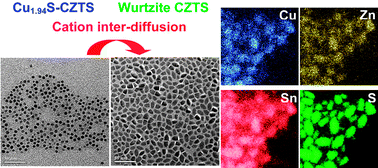Facile synthesis of wurtzite copper–zinc–tin sulfidenanocrystals from plasmonic djurleite nuclei†
Abstract
The present research demonstrates a facile one-pot heating process without injection to synthesize an important light harvesting quaternary

* Corresponding authors
a
Department of Materials Science and Engineering, National Taiwan University, No. 1, Sec. 4, Roosevelt Road, Taipei 10617, Taiwan
E-mail:
suwf@ntu.edu.tw
Fax: +886 2 33664078
Tel: +886 2 33664078
b Academia Sinica, No. 128, Academia Road, Section 2, Nankang, Taipei 115, Taiwan
c Department of Physics, National Taiwan University, No. 1, Sec. 4, Roosevelt Road, Taipei 10617, Taiwan
The present research demonstrates a facile one-pot heating process without injection to synthesize an important light harvesting quaternary

 Please wait while we load your content...
Something went wrong. Try again?
Please wait while we load your content...
Something went wrong. Try again?
H. Liao, M. Jao, J. Shyue, Y. Chen and W. Su, J. Mater. Chem. A, 2013, 1, 337 DOI: 10.1039/C2TA00151A
To request permission to reproduce material from this article, please go to the Copyright Clearance Center request page.
If you are an author contributing to an RSC publication, you do not need to request permission provided correct acknowledgement is given.
If you are the author of this article, you do not need to request permission to reproduce figures and diagrams provided correct acknowledgement is given. If you want to reproduce the whole article in a third-party publication (excluding your thesis/dissertation for which permission is not required) please go to the Copyright Clearance Center request page.
Read more about how to correctly acknowledge RSC content.
 Fetching data from CrossRef.
Fetching data from CrossRef.
This may take some time to load.
Loading related content
